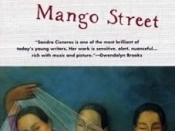In "The House on Mango Street", by Sandra Cisneros, Mango Street is part of a lower class, dangerous neighborhood where women feel imprisoned from life, particularly in the characters of Marin, Sally, and Esperanza. The first woman, Marin, an older friend of Esperanza's, is emotionally imprisoned from the joy of being outside to laugh and talk with friends. Marin is not allowed to leave her home because it is her job to watch her cousins. She is imprisoned in the sense that she has a job and makes money, but she has to stay inside since she is a guest in her aunt's household. Sally, a friend of Esperanza's, is physically imprisoned from being beautiful and communicating with the opposite sex by her father. Sally always has to come home straight after school wearing no makeup and she could not be seen talking with a boy or else she would be beaten.
Sally is imprisoned because of her father's religious beliefs, and because he did not want her to end up as his sisters had. The last woman, Esperanza, is caged in a different way than Marin and Sally are. Esperanza is a stuck in an awful house that she will never call her home, as she says, "You have a home, Alicia, and one day you'll go there, to a town you remember, but me I never had a house, not even a photograph...only one I dream of" (Cisneros 106). Esperanza has bigger ideas planned for her future than those that Mango Street has to offer her, but has no choice but to stay because of her age and maturity level. Marin, Sally, and Esperanza are all emotionally, physically, and mentally imprisoned by the hardships they, and all women, face living in a slum of Chicago.


